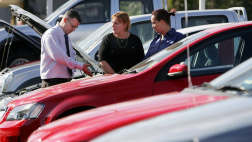The gel, called d3o, is being studied by the UK Military as a lightweight, flexible means of protecting soldiers while Mazda designers in Europe are exploring how the material can save civilian lives.
The d3o elastic polymer gel is very flexible like crazy putty but immediately solidifies on any impact, including bullet penetration or a hit from a hammer. Mazda's chief designer of its European research and development centre, Peter Birtwhistle, says innovations such as d3o were "fascinating" and presented "glimpses of future design".
He says d3o could have applications within the car cabin, such as lining seats for exact body comfort or as a flexible barrier over baby bassinets or as a cargo barrier. "It has unlimited applications in a car to protect its occupants," he says.
The d3o gel is one of hundreds of new materials and concepts being readied now for cars of tomorrow. Others include windows that change colour or tint level on demand or in response to ambient light; car paint that turns to white when hot to reflect heat; integrated communication systems that operate entirely on voice commands; and conventional cars that "lock in" to freeway traffic using a network of infrared sensors.
1. d3o: British-made in 2007, the gel's molecules "shock lock" together to absorb energy. Once the pressure has been relieved, the gel returns to its original pliable state. It can be stitched into fabrics or embedded into equipment. The UK Ministry of Defence has awarded funds to develop the material for military use. Commercially, it is now available in the Ribcap ski beanie and as a case for the iPhone.
2. Ultramid: One-piece plastic car seat backs made of Ultramid weigh 20 per cent less and are 30mm thinner than existing metal-framed seats. Expected on the market in 2013 through French automotive component maker Faurecia, the seats will increase cabin space and reduce vehicle weight.
3. Polycarbonates: Car windscreens could soon be made from plastic to reduce weight. Mazda's Peter Birtwhistle says glass was very heavy but polycarbonates could scratch. But new materials have glass-like properties and yet are lightweight, he says.
4. Paint: Chameleon paint can change colour either automatically in reaction to ambient light, or via a dashboard switch by the owner. Changing the colour of the car easily allows the owner to customise the vehicle and can even include patterns, designs and commercial advertising. In reaction to heat, a car's paint can also change to a lighter colour to keep the car cooler and reduce energy needed for airconditioning.
5. Voice recognition.:A recent US Consumer Electronics Show displayed the Parrot Asteroid, the first car stereo able to download apps and play music using voice recognition. It also accesses real-time traffic updates, geo-localisation, and has a hands-free music search. It will be available in the US this year. General Motors is now initiating a public pilot program for its OnStar in-car communication system that allows drivers to send and receive text messages and update their Facebook status using their voices. The program connects the smartphone to the infotainment system through Bluetooth, allowing drivers to keep both their hands and eyes on the road.
6. Road trains: Volvo's Mobility 2020 project includes road trains comprising of a lead vehicle - a van or truck - which electronically hooks up cars in a chain. The lead vehicle communicates with each car, regulating and monitoring brake, steering and accelerator functions while the drivers become passengers, allowing them to work while commuting. Cars can enter and leave the freeway train at any time, their space taken up by shuffling forward the following vehicles.
7. Bioplastics: These contain varying amounts of organic materials such as corn, kelp or soy. They aren't edible because they're still plastic - they just contain less petroleum. Analysts expect bioplastics to gradually replace traditional plastics, including inside door panels.
8. Cameras: Some cars (Lexus, Mercedes-Benz, Volvo) have multiple cameras to detect lane movements and see behind and in front of the vehicle when parking. But the same visual and sonar/radar technology will allow the car to auto pilot and more effectively run the cruise control.
9. Smart alloys, like the ones pioneered by General Motors, could allow for morphing spoilers and air dams that flow into place on demand and door panels and bumpers that reshape themselves after a collision. These materials are heat-activated, becoming flexible at higher temperatures, and snapping back into shape as they cool. GM next year expects to introduce grab handles that automatically pivot into place when the door is opened.
10. Ultracapacitors: Lithium-ion batteries are powering the next generation of hybrids and plug-in electric vehicles but they are heavy, expensive and in rare cases, can catch fire. An alternative could be ultracapacitors, which are basically low-capacity, high-stability batteries that can charge and discharge quickly without the fire threat. The ext step may be a combination of both Li batteries and ultracaps, which may be a stable, light and less-expensive solution.
11. Keyless: Entry to a car without any keyholes in the doors? Volkswagen's Concept R showcases the keyhole-free doors - a light touch on the door handle unlocks the door and pops it open.


.jpg)


.jpg)













.jpg)
.jpg)




Comments